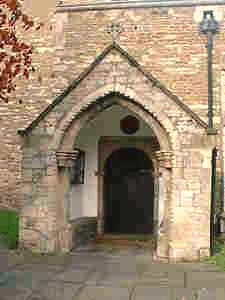The Parish Church of St Lawrence
The most historic building in Scunthorpe
The Parish Church as you see it today contains no work earlier then the later part of the twelfth century. It is not mentioned in the Domesday Survey of 1086.
The earliest known rector was instituted in 1236. He was Rodger, Nephew of Richard, Earl of Cornwall.
The Church was apparently dedicated to St Mary until 1392 when it was appropriated to Revesby Abbey.
Read about the old church.

The porch
'The dog-tooth molding round the arch is 13th century, but the porch has been rebuilt. The vertical shafts are missing and only the capitals remain. The inner arch is Georgian.

The Font
This is Early English with a clustered shaft and what looks like its original lead lining. The front cover is late seventeenth century; modest and dainty.

TheNave
The oak pews of the old church installed, in 1886 were retained in 1913.
The nave and south aisle roof was replaced by Sir Charles Nicholson to accommodate the extension of 1913, but the marks of the original roof supports and the old line of the chancel arch can still be seen in the plaster.

The tower
The tower is Early 13th century, although the top was rebuilt after the ‘steeple' fell in 1602. This is seen in the odd stones of the shafts of the bell openings..The lower west window is an enlargement of 1912. The tower is not square - 20ft by 22ft - which adds to its stumpy appearance. In the ground floor there is a tablet to Thomas Williamson of Rawby near Sleaford, who left £100 for poor widows of Frodingham, Brumby, Scunthorpe and Crosby in 1775.

The Healey chapel
Now known as the Healey Chapel because of the family memorials. There were many more but the raised floor level has covered them. Brass communion rails were put in, in 1883, a new organ in 1886 for which an organ chamber was built in 1896 - the first arch of the chancel is all that remains of this. Nicholson had two further arches cut through, they only differ in the way they die into the pillars.

The Bells
There are three bells. The tenor was in place in 1553 and was the only one to survive the fall of the ‘steeple'.The other two were replaced in 1614 and 1624'

The Lancets
The lancets in the south aisle are Victorian from the rebuilding of 1841. The glass in the old chancel commemorates members of the Healey family.

The Pillars
The round pillars on the north side are 13th century, though with new stone added in 1913. The pointed arcades have original ‘nut and bolt' work. There is a mason's mark on the first pillar and a carved head on the capital. The octagonal pillars on the south side are later. There are mason's marks on the second pillar and some traces of colour.
The New Church 1913
Sir Charles Nickolson Architect
He created a lofty nave with a clerestory, triforium openings to ventilate the roof space. He designed in an essentially modern idiom which, nevertheless harmonizes with the medieval work.
The square pillars of the north aisle are set diagonally, they have no capitals and the arches fade in them. A screen was placed at the entrance to the Healey Chapel.
The new chancel was built on pert of the old churchyard which had been closed for burials in 1885. A brass plate on the east wall of the north aisle records the Chattertons who were buried under the chancel.

The Pulpit
In memory of Mrs. Squire Charlesworth was originally in the old church..

The Lecturn
Given by parishioners on the return of the vicar Revd E M Weigall from Australia.

Credence table
The credence table was found during the 1913 alterations encased within a plain wooden table which had formed the alter of the old church. It has the date 1635 with initials JL (John Leake: Vicar), TB and WJ (William Johnson: Church warden).
.

The Altar Rails
The altar rails are In memory of Lily Hannah Peacock and made by Thompson of J Kilburn - the Mouse Man - his trademark is on them.

The Reredos
The Reredos was Given in memory of Mr. A Peacock by his widow. It is modeled in plaster by an Italian artist named Tosi.
.

The Organ
A new organ was erected in 1886, when an organ chamber was built on the north side of the chancel, and an arch was cut through the wall. In 1913 the organ was moved to its present position and improved and enlarged by the addition of some new stops.
.

The Alms -Bason
This is a fine specimen if Jacobean hand-beaten brasswork, dating from the reign of King James 1 , 1603-1625
.


The grounds and graves
Now maintained by the Borough Council in excellent condition. Just south of the Healey Chapel is a 13th century grave slab with a typical ornamental cross in relief. Another small piece of a similar slab has been used in a tower buttress during the rebuilding.
.
